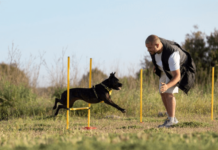
Last Updated on April 1, 2024 by Dogs Vets
Hardest Dog Command to Teach: Canine Challenge
Training a dog can be a rewarding experience, but it also comes with its fair share of challenges. From basic commands like “sit” and “stay” to more advanced tricks like “roll over” and “play dead,” there are a variety of commands that can test your patience as a dog owner.
Mastering dog training commands is a journey filled with barks, wags, and sometimes, puzzled looks from our four-legged friends.
However, when it comes to the hardest dog command to teach, there is one that stands above the rest: “calm down.”
It’s a command that tests the patience of even the most seasoned trainers and reveals the depth of communication possible between humans and dogs.
Welcome to the ultimate canine challenge: teaching the “calm down” and “Leave it” command.
The Art of Teaching ‘Calm Down’
The “calm down” command transcends the simple directives typically taught in puppy school. It’s not just about physical action; it’s about influencing emotion and energy levels.
Herein lies the crux of its difficulty. Dogs, like humans, experience a range of emotions, and teaching them to manage their excitement or anxiety requires understanding, patience, and a nuanced approach.
Understanding Canine Psychology
To embark on this training journey, a deep dive into canine psychology is essential.
Dogs are creatures of the moment, living in a world of immediate reactions and feelings. Their emotional state is influenced by their environment, past experiences, and the energy of their human companions.
Recognizing the signs of overexcitement or stress in your dog is the first step in teaching the “calm down” command.
Why is “Leave It” So Challenging?
“Leave it” is a command that instructs your dog to ignore or let go of something they are interested in, whether it’s a tempting treat on the ground or a squirrel running by.
This command is crucial for their safety and well-being, as it can prevent them from eating something harmful or chasing after something dangerous. However, teaching your dog to resist their natural instincts and desires can be quite challenging.
Tips for Teaching “Leave It”
While “leave it” may be a difficult command to teach, it is not impossible. Here are some tips to help you successfully train your dog:
- Start with a quiet, distraction-free environment.
- Show your dog a treat in your closed hand.
- When your dog tries to sniff or paw at your hand, say “leave it” firmly.
- Wait for your dog to back away or lose interest in the treat.
- Reward your dog with a different treat and praise them for their self-control.
Remember, consistency and patience are key when training your dog. It may take some time for them to fully grasp the concept of “leave it,” but with practice and positive reinforcement, they will eventually master this challenging command.
Creating a Foundation of Trust and Respect
The bedrock of any successful training regimen is the relationship between dog and owner. Trust and respect are not given; they are earned.
Dogs are pack animals by nature, and they seek a leader who is calm, assertive, and consistent. Establishing yourself as this leader is crucial before embarking on teaching complex commands.
Step-by-Step Guide to ‘Calm Down’
- Start in a Quiet Environment: Begin in a setting free from distractions. Your dog’s full attention is needed to learn this challenging command.
- Introduce a Cue Word or Phrase: Consistency is key. Whether it’s “calm down,” “relax,” or another phrase, use it consistently to signal the desired behavior.
- Use Positive Reinforcement: Reward calm behavior with treats, praise, or playtime. Dogs are more likely to repeat behaviors that result in positive outcomes.
- Incorporate Physical Touch: Gently stroking your dog’s back or head can help them relax. Pair this with your calm down cue to reinforce the behavior.
- Practice Regularly: Like any skill, mastering the “calm down” command requires repetition and patience. Short, frequent training sessions are more effective than infrequent, long ones.
Advanced Techniques for Stubborn Cases
For dogs particularly prone to excitement or anxiety, additional techniques may be necessary. Desensitization exercises, where a dog is gradually exposed to exciting stimuli at manageable levels, can help.
Similarly, incorporating calming aids like weighted vests or calming chews can support training efforts.
The Role of Exercise and Mental Stimulation
Physical exercise and mental stimulation are invaluable in managing a dog’s energy levels. A well-exercised dog is more likely to be receptive to training and capable of calming down when asked.
Incorporate activities like long walks, fetch, and puzzle toys into your daily routine.
Common Mistakes to Avoid
- Inconsistency: Changing commands or not practicing regularly can confuse your dog.
- Negative Reinforcement: Punishing your dog for not calming down can increase anxiety, making the behavior worse.
- Lack of Patience: Remember, this command is challenging. Patience and positive reinforcement are key.
The Reward: A Stronger Bond
The journey to mastering the “calm down” command is filled with challenges, but the reward is a stronger, deeper bond between you and your dog. It’s a testament to the power of communication and understanding in the human-dog relationship.
Conclusion
Teaching your dog to “calm down” is more than just training a command; it’s about fostering a deep, empathetic connection with your furry companion. This journey requires patience, understanding, and consistency, but the rewards far outweigh the challenges.
As you and your dog embark on this training adventure, remember that every small success is a step towards a calmer, happier life together.
FAQs
Why is the ‘calm down’ command considered the hardest to teach?
The ‘calm down’ command is challenging because it requires influencing a dog’s emotional state rather than just a physical action, demanding a deep understanding of canine psychology and a strong bond between dog and owner.
How long does it typically take to teach a dog to ‘calm down’?
The time frame varies greatly depending on the dog’s personality, previous training, and the consistency of the training regimen. It can take anywhere from a few weeks to several months.
Can all dogs learn the ‘calm down’ command?
Yes, with patience and the right approach, most dogs can learn to calm down on command. However, the ease and time frame will vary from one dog to another.
Are there specific breeds that find the ‘calm down’ command more challenging?
High-energy breeds may find it more challenging due to their natural disposition, but with consistent training, they too can learn to calm down on command.
What are the signs that my dog is getting stressed during training?
Signs of stress include excessive panting, yawning, drooling, avoidance behavior, and showing the whites of their eyes. It’s important to recognize these signs and give your dog a break.
Can I use the ‘calm down’ command to prevent my dog from barking excessively?
Yes, the ‘calm down’ command can be part of a strategy to manage excessive barking, especially when combined with understanding the root cause of the barking and addressing it.
What should I do if my dog doesn’t respond to the ‘calm down’ command?
Re-evaluate your approach to ensure consistency in the command and rewards. Consider seeking the advice of a professional dog trainer for personalized guidance.
Fact Check
We strive to provide the latest valuable information for pet lovers with accuracy and fairness. If you would like to add to this post or advertise with us, don’t hesitate to reach us. If you see something that doesn’t look right, contact us!
















